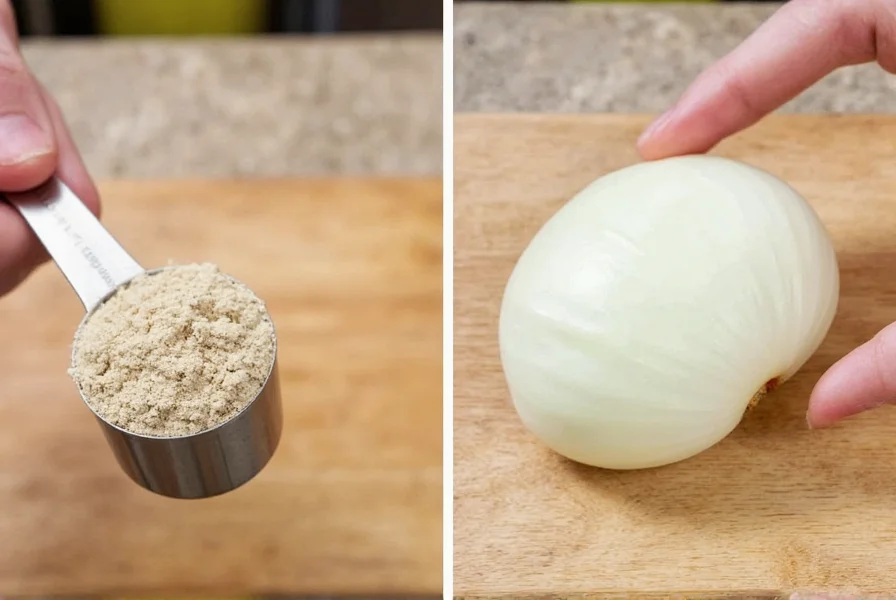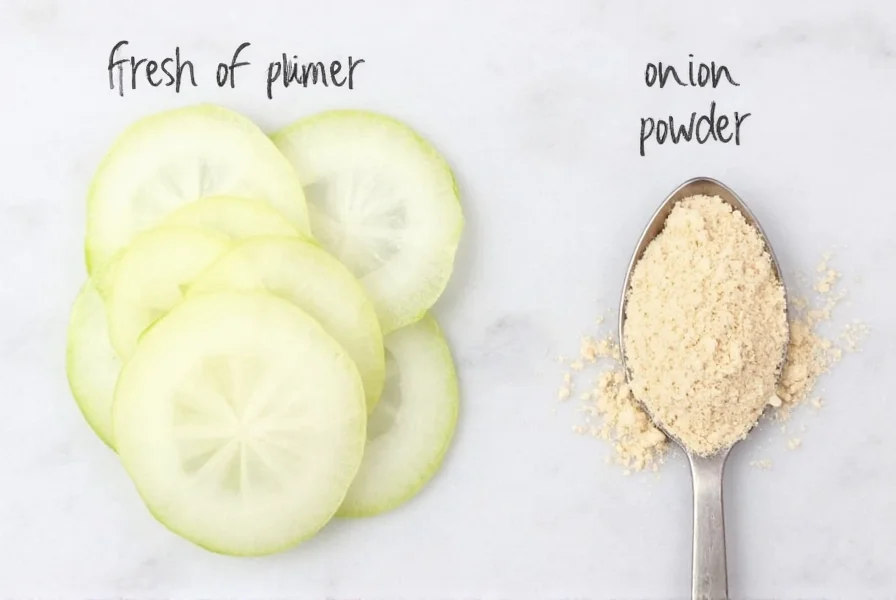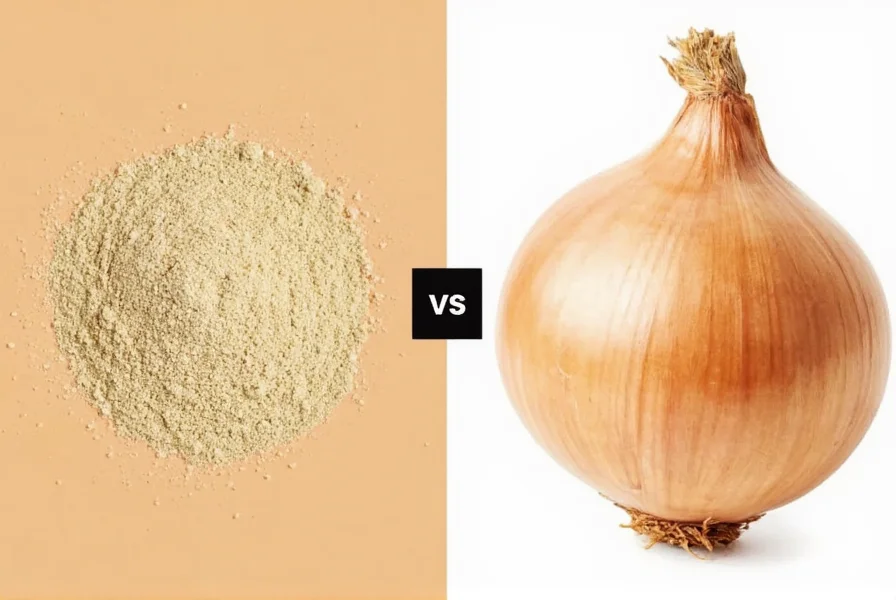When adapting recipes or facing a shortage of fresh onions, knowing the exact onion powder to fresh onion conversion becomes essential for maintaining culinary integrity. This guide provides authoritative measurements backed by professional culinary standards, helping home cooks and chefs achieve consistent results.
Understanding Onion Powder Conversion Ratios
Onion powder represents dehydrated onion with the moisture removed, resulting in concentrated flavor. The standard conversion isn't merely about volume—it accounts for flavor intensity and moisture differences that significantly impact recipe outcomes.
Professional chefs and food scientists agree that the dehydration process removes approximately 90% of an onion's water content while concentrating its flavor compounds. This scientific understanding forms the basis for accurate substitution ratios that prevent under-seasoned or overpowering dishes.
| Onion Size | Fresh Onion Weight | Onion Powder Equivalent |
|---|---|---|
| Small (4" diameter) | 3.5 oz (100g) | 2¼ teaspoons |
| Medium (5" diameter) | 5 oz (140g) | 1 tablespoon |
| Large (6" diameter) | 7 oz (200g) | 1 tablespoon + 2 teaspoons |
| Jumbo (7"+ diameter) | 10 oz (280g) | 2 tablespoons + 1 teaspoon |
Practical Application in Recipe Development
When substituting onion powder for fresh onions, consider these critical factors that affect your onion powder measurement conversion:
Moisture Content Compensation
Since onion powder lacks the moisture of fresh onions, you may need to adjust liquid ingredients in baking recipes. For every tablespoon of onion powder replacing a medium onion, consider adding 1-2 teaspoons of water or broth to maintain proper dough or batter consistency.

Flavor Intensity Management
Onion powder delivers more concentrated flavor than fresh onions. When converting recipes that call for sautéed onions—which mellow during cooking—reduce the onion powder by 25% to prevent overpowering the dish. This adjustment creates the perfect onion powder equivalent for cooked dishes.
Timing Matters
Add onion powder early in the cooking process for soups, stews, and sauces to allow rehydration and flavor integration. For dishes with short cooking times like stir-fries, sprinkle onion powder in the last 2-3 minutes to preserve its delicate flavor compounds.
Common Substitution Mistakes to Avoid
Many home cooks make critical errors when converting between fresh onions and onion powder that compromise recipe results:
- Ignoring onion variety differences: Yellow onions (most common medium onions) have stronger flavor than sweet Vidalia onions, requiring different conversion approaches
- Using heaping measurements: Onion powder compacts easily—always measure level tablespoons for accurate how much onion powder per onion calculations
- Not accounting for recipe type: Baking requires more precise measurements than hearty stews where flavor can mellow during long cooking

When Onion Powder Outperforms Fresh Onions
Certain culinary applications actually benefit from using onion powder instead of fresh onions:
- Dry rubs and spice blends: Provides even flavor distribution without moisture that could clump spices
- Quick breads and biscuits: Prevents pockets of raw onion flavor while delivering consistent onion taste
- Commercial food production: Offers consistent flavor profile unaffected by seasonal onion variations
- Emergency cooking situations: When fresh onions aren't available but flavor complexity is needed
Understanding these specific use cases helps determine when the onion powder to fresh onion ratio becomes not just a substitution but an improvement to your culinary creation.
Measuring Techniques for Precision
Accurate measurement separates adequate cooking from exceptional results. Follow these professional techniques:
- Fluff onion powder with a fork before measuring to prevent compaction
- Use metal measuring spoons (not plastic) which create less static
- Spoon powder into the measure—don't scoop directly from the container
- Level with a straight edge rather than shaking the spoon
- Store onion powder in an airtight container away from light and heat
These methods ensure you achieve the precise how much onion powder is equal to one onion measurement your recipe requires.
Advanced Conversion Considerations
For professional culinary applications, consider these additional factors:
- Brand variation: Different manufacturers use varying dehydration processes affecting potency
- Freshness factor: Older onion powder loses potency—smell before using (should have strong aroma)
- Recipe acidity: In highly acidic recipes (tomato-based), increase onion powder by 10-15% as acid suppresses flavor perception
- Salt content: Many commercial onion powders contain anti-caking agents with salt—adjust overall recipe salt accordingly
Mastering these nuances transforms the basic onion powder equivalent to fresh onion conversion from simple substitution to culinary artistry.
Can I use onion powder instead of fresh onions in all recipes?
While onion powder works well in most cooked dishes, soups, and baked goods, it doesn't provide the same textural element as fresh onions. Avoid substituting in raw applications like salads, salsas, or garnishes where fresh onion's crisp texture is essential to the dish.
Does the conversion differ for onion flakes versus onion powder?
Yes, onion flakes require different conversion ratios. For onion flakes, use 3 tablespoons to equal one medium fresh onion. The larger particle size means flakes contain more air space than finely ground powder, requiring greater volume for equivalent flavor.
How do I adjust recipes calling for caramelized onions?
For caramelized onion substitutions, use 25% less onion powder than standard conversion (about 3/4 tablespoon per medium onion) and add 1/2 teaspoon of sugar to mimic the natural sweetness developed during caramelization. The Maillard reaction that creates complex flavors in caramelized onions cannot be fully replicated with powder alone.
Can I make my own onion powder for more accurate conversions?
Yes, making your own onion powder ensures freshness and consistent potency. Dehydrate thinly sliced onions at 135°F (57°C) until brittle (6-12 hours), then grind to fine powder. Use 1 cup of fresh onion slices to produce approximately 2 tablespoons of homemade powder, creating a more reliable conversion ratio than commercial products.
Why does my dish taste different when using onion powder instead of fresh onions?
Fresh onions contain enzymes that create different flavor compounds when cut or cooked. Onion powder lacks these active enzymes, resulting in a more one-dimensional flavor profile. For closer approximation, combine onion powder with a small amount of fresh garlic (which shares some flavor compounds with raw onions) and allow the dish to rest for 30 minutes before serving.











 浙公网安备
33010002000092号
浙公网安备
33010002000092号 浙B2-20120091-4
浙B2-20120091-4